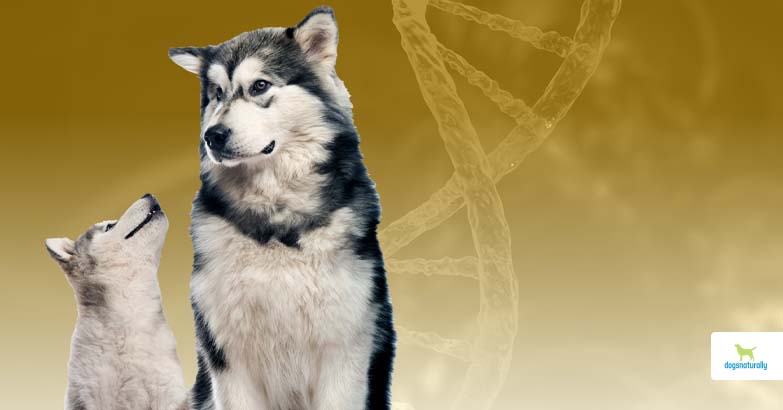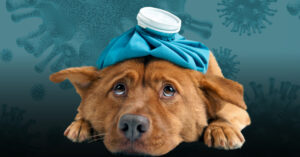Unsurprisingly, DNA can play an essential role in canine disorders. After all, a dog’s DNA influences not only his physical characteristics but also his exposure to various diseases that might affect dogs throughout his lifespan.
Before listing some prevalent genetic diseases in dogs, we must accept that many of these issues are largely connected with closely related dogs’ offspring. Similarly, hybrid pups may be somewhat more resistant to congenital canine diseases.
The most common inherited genetic issues in dogs are:
- Hip dysplasia
- Bladder stones
- Allergies (especially skin)
- Epilepsy
- Chondrodysplasia
- Patella luxation
Some other less common hereditary issues include the following:
- Some cancers, such as lymphoma, MCT, and osteosarcoma
- Hypothyroidism
- Mitral valve disease
- Inflammatory bowel disease
- Diabetes mellitus
- Retained testicles
- Umbilical hernias
Continue reading to learn about the most common inherited diseases found in dogs, how you can recognize them, and what steps you can take to lessen their impact on your dog.
The Most Common Genetic Diseases in Dogs
Most genetic diseases that affect mixed-breed and purebred dogs are caused by disease-liability genes that have been around for a long time. These appeared before the division of breeds and are spread across the genome of the domestic dog. The incidence of disease in pedigreed breeds may vary from one another depending on the frequency of liability genes present in their respective gene pools. The inherited disease has a predictable start and course. It is possible to enhance the diagnosis, treatment, and control of genetic illnesses by first identifying the predictable triggers and modifiable factors that influence the appearance of the disorders.
Hip Dysplasia
Although hip dysplasia is usually associated with GSDs and other dog breeds closely related to them, many other giant dog breeds, such as Saint Bernards, are at maximum risk for developing the condition. It is because enormous and tall/giant dog breeds of today develop faster and gain muscle mass faster than their skeletons. The imbalance of growth modifies weight placement on the dog’s hip joint, which leads to the deformation of bones around the joint, ultimately resulting in lots of dysplasia.
Prominent Symptoms
- Pain
- Reduced motion or reduced activity level
- A difficulty or a lack of willingness in leaping, sprinting, climbing, or rushing upstairs
- Ineffectiveness in the hind legs
- Reduced muscular mass in the thighs
- An obvious shoulder muscle expansion (due to the animal trying to compensate for its weaker rear end).
Diagnosis
Hip radiographs performed while the patient is under general anesthesia are the optimum way to make a diagnosis of hip dysplasia. Hip dysplasia may also be indicated by clinical symptoms and a palpable looseness of the joints.
Natural Treatment
Dogs who have hip dysplasia may benefit tremendously from participating in hydrotherapy. Using an underwater treadmill or performing exercises in a pool are also components of this form of treatment. Because of the buoyancy of the water, your dog’s joints won’t be subjected to as much pressure, and they’ll be able to exercise their hind leg muscles without experiencing any pain.
RELATED: Natural ways to manage hip dysplasia in dogs …
Urinary Bladder Stones
Although bladder stones are occasionally an unexpected incidental finding on radiographs, stones in the urinary tracts of many dogs cause discomfort and substantial clinical difficulties. Urinary accidents, difficulty passing urine, increased urination frequency, and the presence of blood in the urine are all symptoms of this condition.
A dog of any breed or mixed ancestry can acquire bladder stones; however, certain purebred dog breeds, such as Dalmatians, Newfoundlands, Bichon Frises, and Miniature Schnauzers, are more likely to be affected by this condition than other canines.
Prominent Symptoms
- Accidents in the house
- Bloody urine
- Reduced appetite
- Licking private parts more frequently than normal
- Pungent urine
- Urinate more frequently than normal
- Vomiting
- Difficult urination
Diagnosis
Tests such as urinalysis, blood cultures, and blood work, along with ultrasound or x-rays, may be recommended by your veterinarian to assist in identifying bladder stones and estimating their size.
Conventional Treatment
A cystotomy is a time-honored procedure involving the surgical removal of urinary bladder stones. Cystoscopy and laser lithotripsy are two more procedures that may be performed.
Natural Treatment
An increased water intake can put pressure on smaller stones to be expelled from the kidneys and is considered the best natural remedy for stone removal in canines. Other than that, reducing the amount of the substances that make up the stones in the diet is also helpful. Depending on the type of stone, diet changes can be helpful (click on the link below). If everything fails, then surgery or lithotripsy is the best option.
RELATED: Home remedies for bladder stones …
Allergic Skin Disease
The most common manifestations of disease in clinical practice are allergic skin diseases (eg chronic inflammatory otitis, recurrent hot spots, pruritus). These clinical manifestations are pretty prevalent in canines of mixed and purebred ancestry, with some breeds having a higher chance of the condition than others.
RELATED: Read about some surprising reasons for allergies …
There is currently no genetic-liability testing that can be done. Predictable seasonality can be identified in 15% to 62% (median 30%) of chronically allergic dogs. Before it develops into a clinical disease, the pruritus that these individuals are experiencing ought to be managed by interventional methods.
Prominent Symptoms
- Loss of fur
- Constant head shaking
- Itchiness and scratching
- Excessive licking, particularly their paws.
- Gnawing
- Biting
- Rash, redness
- Dry skin
Diagnosis
The allergy diagnosis in dogs may be accomplished using either intradermal skin testing or RAST testing. Each approach offers a unique set of advantages and disadvantages. Intradermal skin testing has been recognized for a long time as the “gold standard” for establishing the reason behind atopic dermatitis; nevertheless, only specialized veterinary dermatologists are authorized to conduct it.
Natural Treatment
Changing the diet of your pet and managing gut health can help. Other than that, applying Epsom Salt, Apple Cider Vinegar and giving herbs or supplements can also help your pet in recovery.
RELATED: Read more about managing dog allergies naturally …
Epilepsy
Seeing your dog experience a seizure is terrifying and upsetting. Dogs often become rigid and collapse to the ground while experiencing a grand mal seizure. They will also salivate and paddle their legs; some may lose control of their urine or intestines or make vocalizations. When brain cells get too stimulated, a seizure develops. Idiopathic epilepsy, also known as epilepsy with an unknown basis, is the diagnosis of choice in cases where the root cause of repeated seizures cannot be identified.
Although additional research is required, preliminary findings suggest that some dog breeds, including German Shepherds, Beagles, Belgian Tervurens, Keeshonds, Dachshunds, and Golden and Labrador Retrievers, have an increased risk of inheriting the epileptic condition. Anticonvulsant medicine is typically used in the treatment of epilepsy. One pill or a mixture of pharmaceuticals may be administered to the dog to control the seizures, depending on the breed. Since epilepsy is incurable, medication aims to reduce seizure frequency and severity.
Prominent Symptoms
Complete lack of control over voluntary actions, most frequently accompanied by convulsions, shaking, twitching and jerking.
Diagnosis
If you suspect your dog has seizures, you should take him to the veterinarian as soon as possible so that he may get a comprehensive examination. This will involve obtaining a thorough medical history, undergoing a complete physical examination, and having blood work performed to assist in determining the root cause of the seizures and the most effective treatment method. Your pet’s brain may need to be evaluated via an MRI in addition to searching for other potential reasons for the seizures.
Conventional Treatment
Anticonvulsant medicine is typically used in the treatment of epilepsy. One pill or a mixture of pharmaceuticals may be administered to the dog to control the seizures, depending on the breed. Since epilepsy is incurable, medication aims to reduce seizure frequency and severity.
Natural Treatment
Some several natural treatments and approaches may be used to halt or prevent seizures in dogs. Some of the more prevalent ones are as follows:
- Change in diet
- Use of essential fatty acids, especially omega-3
- Use melatonin to induce sleep, which also helps in controlling seizures.
- A teaspoon of honey, once or twice a day, is also helpful in seizures.
- Homeopathic remedies can be very effective. The correct remedy for your dog must be prescribed by a professional homeopath after analyzing your dog’s individual case and symptom picture.
- Homeopathic remedies such as Aconite and Belladonna, are popular in liquid form for seizures because they allow pet owners to give their animals medication even if they are having a seizure. These remedies can be massaged into the skin or even onto the gums of a convulsing animal. However, care must be taken to prevent getting bitten in the process.
RELATED: Natural remedies for dog seizures …
Chondrodysplasia
Chondrodysplasia causes short, warped legs in Dachshunds (wiener dogs) and Bassett Dogs. The “standard” for their breed ultimately leads to severe deformities in the bones and essential joints of the limbs and severe arthritis in later life.
Lack of adequate shortening of the back side exerts excessive stress on the vertebral disks, causing disc disease. Disc disease can cause back pain or estrangement and partial or complete paralysis.
This condition is caused by a mutation in the FGF4 allele/gene, which causes disk difficulties. There’s no way to anticipate which canines will get disk disease later in life.
Prominent Symptoms
- Legs are in proportion with each other but not to the canine body
- Lack of total or partial growth in the puppy
- Protrude out the lower jaw
- A crooked backbone
- Bent in or bowed front legs
- Short stature
- Heart problems
Diagnosis
The afflicted dogs have limbs that are noticeably shorter than those of healthy canines. In addition, skeletal anomalies can manifest themselves, such as much shorter projecting toes on the outside side of the front paws, bent forelimbs, shortened vertebral bodies, and significantly delayed bone formation of carpal bones. All these indicate chondrodysplasia.
Treatment
Because bone abnormalities can create a great amount of discomfort for your dog, natural calcium supplements and natural pain medications can be of assistance.
Chondrodysplasia can sometimes cause to mobility issues, in which case support is also provided, or a dog wheelchair may be required to keep the dog active and decrease the pressure that is placed on the joints. Chondrodysplasia is a condition for which no definitive treatment exists, and the treatment strategy for each dog will be different.
Patellar Luxation
Patellar Luxation is a complex condition inherited and can cause the kneecap to dislocate from the trochlea in either the medial or the lateral direction. It’s more common in smaller breeds, but some larger species also have it. Patella luxation may not cause symptoms but can lead to pain, instability, and arthritic changes. Maintaining a healthy weight is one of the essential factors in reducing morbidity.
Prominent Symptoms
A dog or cat with patella luxation will usually display a “skipping” or “jumping” lameness, which means that it will keep its leg up for many steps while they are running, and then it will return to its normal position.
It is possible to observe “bunny hopping” or pulling of the legs for brief periods when both legs are afflicted, in addition to an unnatural and rigid gait. This is not often unpleasant, but it can, over time, progress to a disease called osteoarthritis, which is much more painful.
Diagnosis
A misplaced patella usually indicates that your dog is suffering from patellar luxation. The veterinarian may also order X-rays to examine the knee joint and the tissues surrounding it to identify any underlying injury.
Treatment
Most cases of patella luxation may be treated conservatively and do not require surgery. Building up the leg muscles and preventing the kneecap from slipping can be accomplished through physiotherapy and carefully planned exercise.
RELATED: Luxating patella in dogs: Is surgery really necessary?
Conclusion
We hope you better understand all dogs’ common genetic or hereditary issues. It’s better to be concerned with the vet appropriately if your pup is facing any genetic problem. Additionally, the mating of healthy parents (preferably OFA-tested for health conditions common in the breed) can significantly reduce the likelihood of genetic issues.
References
van Steenbeek, FG, Hytönen, MK, et al (2016), The canine era: the rise of a biomedical model. Anim Genet, 47: 519-527.
Marjo K. Hytönen & Hannes Lohi (2016) Canine models of human rare disorders. Rare Diseases, 4:1
Karlsson, E., Lindblad-Toh, K. Leader of the pack: gene mapping in dogs and other model organisms.Nat Rev Genet 9, 713–725 (2008).













